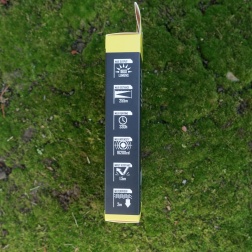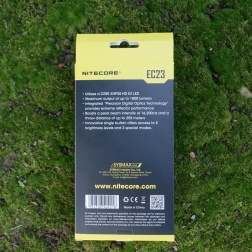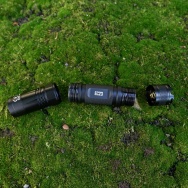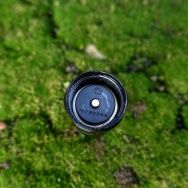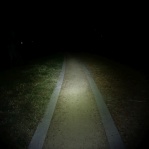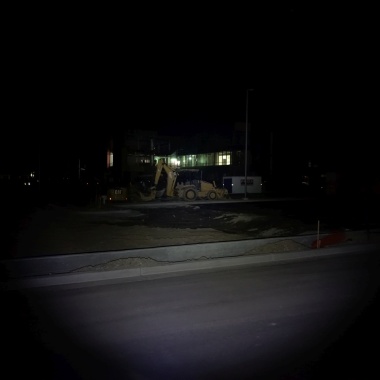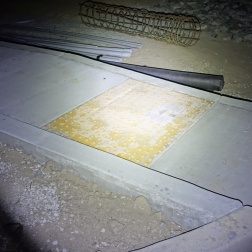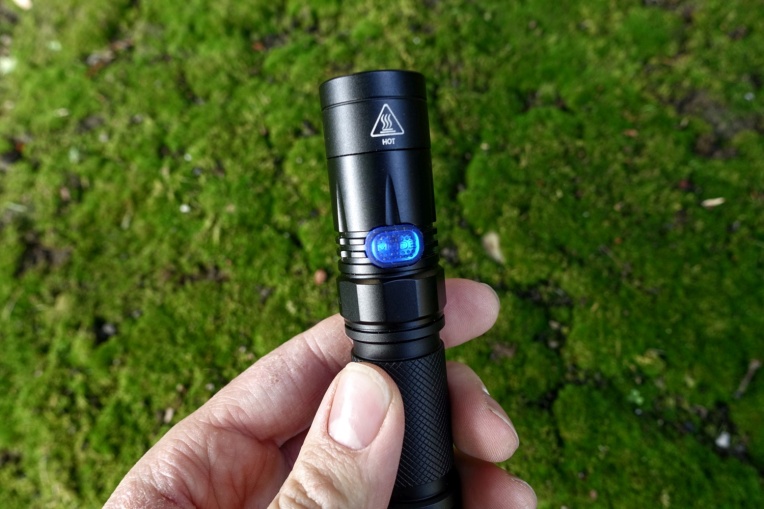Hi All! Nitecore sent me their updated EC23 1x18650 light and I wanted to share my thoughts here. Please leave a comment if you have any questions or comments.
Nitecore’s new EC23 is a revamp of the previous EC20 featuring a brand new LED, which has almost double the output, and a new UI. If you are a fan of the simple look and feel of the EC20 but looking for the next generation of output, then say hello to the EC23!
OVERVIEW
Overall, I love the output and I like the feel of the large tactile side switch over the metal one on Nitecore C1. I do like the turbo boost but it comes with some confusing quirks to the UI. The total package feels a bit sparse (no pocket clip or holster) but this is probably the most budget friendly light 1×18650 in Nitecore’s current generation offerings. Also, you may need to buy a new high amperage battery to get the most out of the light.
QUICK SPECS
Here is the spec sheet from Nitecore’s EC23 product page. Note, to get TURBO you need a battery than can provide 8A.
FEATURES
OTHER DIMENSIONS
- Length: 128.7mm (5.07″)
- Head and Tube Diameter: 25.4mm (1″)
- Weight: 78g (2.75oz) (without battery)
INCLUDED
Overall, the whole kit is a bit sparse a pocket clip or a holster would have been a nice addition. Also, I’m a bit surprised that the box doesn’t display the entire FL-1 table for each mode.

- EC23
- Lanyard
- Spare O-rings
- Manual (manual PDF)
- Warranty Card
OPTIONS
There is currently only one base model available and there are no kits or sets either.
PRICE
The price at time of writing: ~ $55 USD
LOOK & FEEL
OUTSIDE
The body has a very inviting look and feel with a very smooth and shallower diamond knurling with an additional bit of hexagonal shape near the head for anti roll. I love the large tactile, silent, and back-light side switch as it’s very easy to find in the dark but does, understandably get pressed sometimes while carrying in a pocket.
The light can tail stand nicely, and the tail cap even has a notch to let a pretty thick lanyard through (at least that’s the only explanation I can come up with) but I bet this could be configured a little better.
INSIDE
Overall, I’m happy with the build quality. One of the satisfying parts for me is not having to push on the tail cap to bring the threads together, when using and IMR battery; I can set the cap on lightly and just screw it on. Other nice features are: gold-plated and a beefy spring, brass-looking anode, anodized and square cut threads, and a thick body tube. One thing to watch out for is that the head can loosen and loose contact. There seems to be a tiny little bit of rattling inside the head.
ACCESSORIES
Not much to speak of except the standard issue Nitecore wrist lanyard.
OPTICS
LED SPECS
The light features a newer domed CREE XHP35 HD E2, (CREE Spec Sheet)

TINT
The corona is a bit yellow/green with the edge of the spill having a purple color (possibly caused by the anti-reflective coating on the lens). Overall, not my favorite white-wall shots but but I kind of like the concept of a bit higher CRI in the center with a brighter feeling spill. Below is a comparison of the EC23 (left) with a Nichia 912B (CCT~5000K) in Nitecore’s MT06MD penlight (right).
BEAM PROFILE
Overall the beam profile is a bit all over the place. Starting with the hot spot, standing back a few feet there is a dark spot right in the middle; the edge of the corona seems to get dimmer further away from the center but the spill afterwards looks brighter; finally, there is a tiny bit of a halo around the spill.
BEAM ANGLE
Using a basic protractor I measured the beam angle coming out of the light to be about a 60° total spill with a 15° hot spot.
OUTPUT LEVELS
Overall, I’ve been happy with the output mode spacing. Below are some pics from Ultra Low to Turbo. I’ve also included my beamshots youtube video which goes through each of the levels.
OUTDOOR BEAMSHOTS
White wall analysis is one thing but outdoors is another. Overall, what stands out is that I can still see the bit of purple spill. All the pictures below are taken with the light in TURBO.
POWER
BATTERY
No battery is included with the off-the-shelf package; however, Nitecore did send me a 3100 mAh 35A IMR battery for testing purposes. Below is the battery options I pulled from the manual. It’s important to note that cells with 8A are needed to get TURBO. It’s also nice to see that IMR batteries are officially recommended.
The length of the body tube can accommodate protected cells just fine.

INDICATORS
There are several power indicators but not explicit mention of built-in low voltage protection (LVP). You can always check the battery voltage from off by loosening and then tightening the tail cap and the voltage will blink out on the mode button (3.7v = 3 blinks, pause, 7 blinks). Once power reaches ~50%, the indicator light will blink once every two seconds; at ~10% power the indicator will blink repeatedly.
PERFORMANCE
TURBO is an instant burst which immediately decreases over a span of ~5min. The runtime on TURBO and HIGH are about 2h 30m and 2h 50m, respectively, with setting it and leaving it alone (no resetting of mode to try to regain the highest brightness). There is no PWM on any mode. The light appears to be temperature regulated with experiencing max temp of ~110°F (43°C). The constant strobe at ~18hz at and appears to be almost as bright as TURBO.
NOTES ON METHODS
I measured the light output in relative LUX and I have not spent time yet to calibrated for lumens or factored % of max output. The charts I’ve provided, while are literally quantitative, I suggest using as a qualitative reference for how the output may behave over time; typically lights aren’t left on this long and the max output can be reset. It’s worth to note that the runtime table provided by Nitecore states, “Runtime for TURBO [and] HIGH is calculated based on theoretical arithmetic.” so there isn’t physically reproducible in my tests.
PWM check using a 50 millisecond test period with a sampling rate of 3,000 times per second. For special modes I used a 150 millisecond test.
Temperature measurement condition is at room temp and currently no fan cooling.
I am still very new at doing these types of measurements so I am no authority on on this subject, but please let me know if things don’t look right or you see anything that I could do to improve for next time.
BATTERIES USED FOR TEST
The below battery was either provided or recommended by the manufacturer. Make sure that you carefully research any cell you are considering using before purchasing.
- Brand: Nitecore
- Model: IMR18650
- Positive Contact: flat-top, flush with cell body
- LVP: non-protected
- Voltage: 3.7
- Capacity: 3100 mAh
- Current: 35A (PULSE), 20A (MAX Continuous)
- Cell Length: 65mm
RUNTIMES
The TURBO has quite a spike in the beginning and immediately decreases over about 5 min. On HIGH I got about 2h 50m with just turning on the light and leaving it.
PWM CHECK
There appears to be no significant PWM on any constant mode. I did measure a 18ms refresh cycle where the lx varies by about 50 but does not drop to zero lx on any but the U.LOW mode.
For comparison, the second graph shows PWM varying from 0 to 120 lx on the LOW mode on the Nitecore R25 flashlight.
STROBES
Strobe frequency is about 18hz.
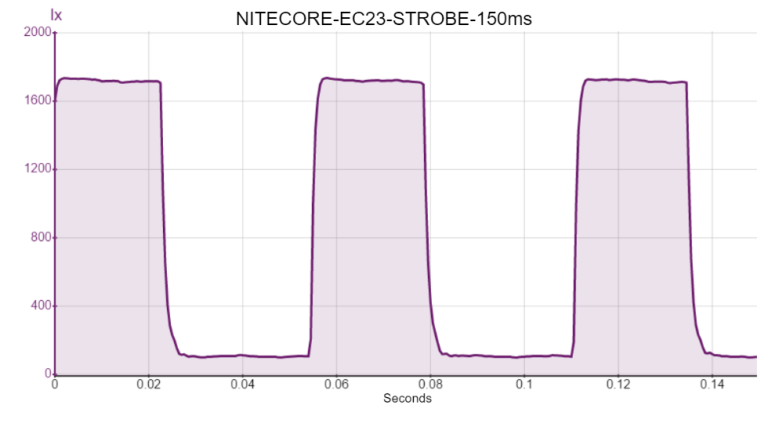
BEACON
Frequency is 1 flash every 2 seconds, with the flash lasting about 0.1 seconds.
TEMPERATURE
A max temp of 109.2°F was observed for TURBO. Usually Nitecore’s temperature “limiter” is set to 120°F but maybe they lowered it to 110°F, the manual doesn’t say.
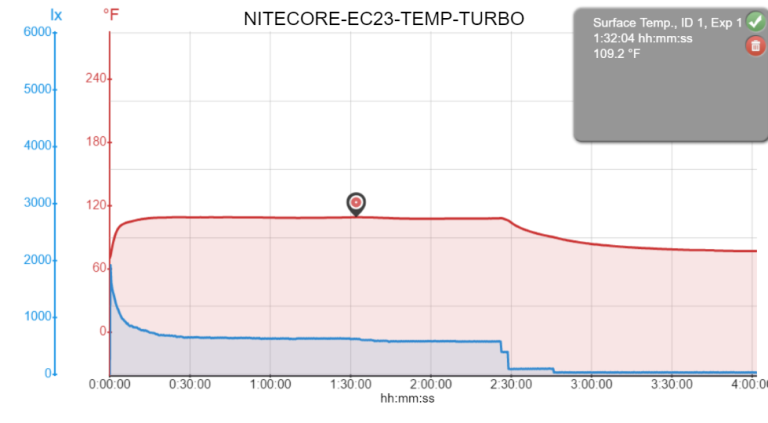
USER INTERFACE
Overall, I’m not a fan of the UI because of the 3 second timer before the primary mode gets locked in. I like to constantly adjust my brightness based upon conditions; in order to adjust your primary output (after 3 seconds) you basically have to turn off the light and start again. I would have liked to see a double click be a shortcut to TURBO whether in ON or OFF, and a follow up double click would go back to the last memorized mode.
Few other thoughts:
- From OFF, the shortcut to TURBO is a bit of a wait, wish it was a simple double click
- When OFF and you press and hold the switch you will ultimately go through three modes, U.LOW, TURBO, and momentary TURBO; this is a bit confusing at first
- I am happy to see that TURBO can be latched and memorized
- I’m happy to see no electronic lockout since there is physical lockout available
CONCLUSIONS
HIGHLIGHTS
- Love the side switch; very tactile and great indicator light behind it
- High light output, of course any 1″ diameter light that can do almost 2k lumens with current gen LED comes in handy
- Pretty easy to pocket, knurling not very aggressive but still has anti-roll
- Good temperature regulation, max temp was cooler than expected
- Solid body and head design
COMMENTS
- UI is tricky if you like to adjust your output a lot, people how need a flashlight for a single task may really like this scheme
- UI is slow, both cycle through modes and to get to TURBO from off
- Beam tint mixture and profile are not my first choice
- Need higher current battery (not included but tube fits protected cells just fine too)
- The lanyard loops and openings could be reconfigured better for thicker paracord style lanyards
- A little sparse on the included accessories
- No full lumen/runtime table on the box
PURCHASE
The current price for the light is about $55 USD and if you appreciated my review and would like to support me, feel free to check out this product on amazon using my affiliate link (does not cost you more, amazon gives me very small % of their profit):
Amazon Link: NITECORE EC23 1800 Lumens High Performance Compact LED Flashlight
Accessories
NOTES
Disclaimers:
- CivilGear Reviews received this product for testing and providing an honest review.
- CivilGear Reviews was not paid for writing this review.
- CivilGear Reviews is a participant in the Amazon Services LLC Associates Program, an affiliate advertising program designed to provide a means for sites to earn advertising fees by advertising and linking to amazon.com




